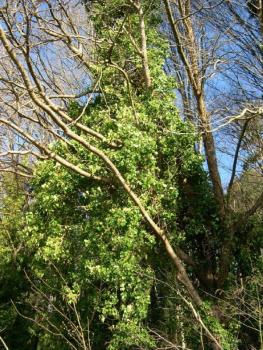English Ivy
Figures 1 and 2: Juvenile and mature English Ivy, King County, 2017 from http://www.kingcounty.gov/services/environment/animals-and-plants/noxiou...
Hedera helix
Common Names
English ivy, common ivy, European ivy, ivy, Atlantic ivy, Irish ivy, True ivy, gum ivy, woodbine, winter-green, winter-grunt, kissos, bergflétta (The Herbal Resource)
First Nation Names
Because this plant is originally from Europe (native to Europe and western Asia) and was introduced around 1727 (earliest record), there are no first nation names that are commonly used and widely known. It was originally introduced to the United States most likely by European immigrants as a garden ornamental (Clackamas Soil and Water Conservation District, 2017).
Family
Hedera
Identification
English Ivy is characterized by veins with pointed, green leaves that can reach up to 30m in length, and that have small aerial clinging roots (Clackamas SWCD, 2017). Ivy is known to shade out and smother plants. There are two forms of ivy; one form is its juvenile, vegetative growth phase and the other is its mature, sexual growth phase (Clackamas SWCD, 2017). Evergreen leaves alternate on the ivy vines and have 3-5 lobes with young, but change to less-lobed once maturity is reached (Clackamas SWCD, 2017). Flowers and fruits are cluster and are white-greenish and dark blue-blackish respectively (Clakamas SWCD, 2017).
Cautions
According to Clackamas SWCD, the leaves and berries can be toxic if ingested to humans and cattle because they contain the glycoside hederin (Clackamas SWCD, 2017). English ivy also can suffocate understory plants and can cause increased wind throw if it climbs up trees (Clackamas SWCD, 2017). It grows very fast and can reproduce vegetatively from small fragments, making invasion quick and removals difficult. When removing the species, there is a possible risk of dermatitis, so it is recommended that when handling the plant, gloves and full clothes are worn (Clackamas SWCD, 2017). Using ivy as a medicine should be avoided during pregnancy unless otherwise directed by a qualified health care provider according to Clackamas SWCD, 2017).
Reproduction
English ivy can either reproduce from fragments of stems or sexually from mature seeds (Clackamas SWCD, 2017). Berries can be eaten by birds and this aids in their dispersal, in addition to human dispersal. English ivy is potentially a very long lived plant, even though it can reach maturity in 10 years. 100 year plants are well documented in England, and one was recorded at over 400 years of age (Clackamas SWCD, 2017).
Current Distribution and Local Habitat
English ivy is found in many places across North America – Atlantic states including Florida, Hawaii, provinces and states around the Great Lakes, and Western Provinces (Waggy, 2010). On the west coast, English ivy occurs in forests with deciduous or mixed forests and is a problem in all forests on the coast below 900m (Waggy, 2010). Ivy is native to Europe and West Asia, also occurring in northern Africa (Waggy, 2010).
Ethnobotanical Uses
English ivy was used medicinally for many things, but also has symbolic importance. It was the female side to masculine holly, used to decorate for Christmas, and made into wreaths for married couples (The Herbal Resource, 2017). It was traditionally used internally and externally for many different ailments. Internally it was used for the liver, spleen, gallbladder disorders, gout, arthritis, and dysentery (The Herbal Resource, 2017). Burn wounds, calluses, cellulitis, inflammations, parasitic disorders, and rheumatic complaints were all external ailments that ivy was used for (The Herbal Resource, 2017). Today it is used as a natural respiratory tract congestion treatment (The Herbal Resource, 2017). The leaf extracts may have antioxidant properties, in addition to having antiviral and antimycotic properties (The Herbal Supplement, 2017).
View presentation on how to make an English ivy wreath and dream catcher with this presentation.
Written by Caitlyn Jimmo
References
The Herbal Resource. English Ivy – Side Effects and Health Benefits. Herbal Resources. Last updated 2017. Accessed on November 21, 2017 from https://www.herbal-supplement-resource.com/english-ivy-herbs.html.
Clackamas Soil and Water Conservation District. BMP: English Ivy (Hedera helix). WeedWise: A conservation program of the Clackamas SWCD. Last updated 2017. Accessed on November 26, 2017 from https://weedwise.conservationdistrict.org/weeds/english-ivy.
Waggy, M. A. (2010). Hedera helix. In: Fire Effects Information System. U.S. Department of Agriculture, Forest Service, Rocky Mountain Research Station, Fire Sciences Laboratory (Producer). Accessed on November 28, 2017 from https://www.fs.fed.us/database/feis/plants/vine/hedhel/all.html#HabitatT....
King County. English ivy identification and control – Hedera helix. King County. Last updated 2017. Accesssed on November 26, 2017 from http://www.kingcounty.gov/services/environment/animals-and-plants/noxiou....
Project Status:
Year:
Associated Projects:
Image:

